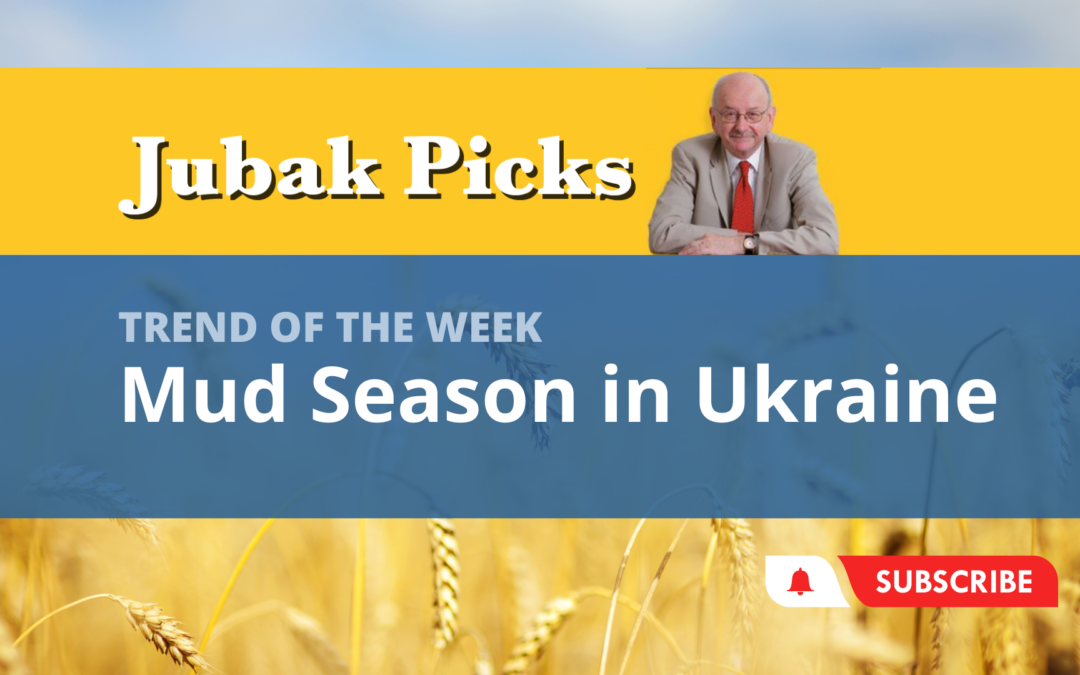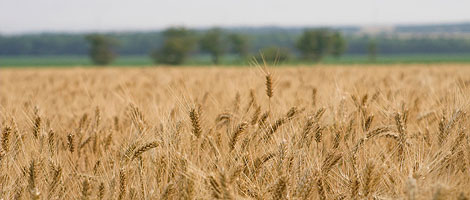
November 7, 2022 | Daily JAM, Videos |
Today I posted my two-hundred-and-second YouTube video. This week’s Trend of the Week: Mud Season in Ukraine. During World War II, the western powers were hoping for a tough mud season to slow down the war and make it harder for Germans to race into Poland. Instead, a historically dry mud season led to German Panzers easily rolling deeper and deeper into Poland. In Ukraine, we can expect mud season to start to affect the war relatively soon-it’ll likely not slow the violence (it might even get worse), but lines will be stuck in place as travel through the mud will become treacherous and tanks and troops will be relegated to roads. Since the recent escalation of the war, Russia has announced its grain deal with Ukraine to get grain out of the country was off and then on–and think off again is a real possibility after the deal expires on November 19. All this means more uncertainty and higher prices in the grain market. I think you’ll see ETFs like Teucrium Wheat Fund (NYSEARCA: WEAT) and Teucrium Corn Fund (NYSEARCA: CORN) rise as prices for grain go up. These two ETFs are a way to hedge the rising costs of grain and volatility in stock prices.

October 25, 2022 | CORN, Daily JAM, Volatility |
It’s not like the grain export deal that Russian President Vladimir Putin signed is working all that all. Grain exports from Ukrainian ports on the Black Sea are running at an estimated 25% to 30% of pre-war levels. But any exports of Ukrainian grain have been a boon for consumers struggling with food inflation. And especially for consumers in developing economies where the issue hasn’t been just the price of food but also its availability at all. But that deal expires on November 19 and no one knows whether or not President Putin will renew it.

September 12, 2022 | Daily JAM |
News this weekend that Ukrainian forces had pushed to the Russian border with the country in the Kharkiv oblast is likely to provoke a big reaction from Russian President Vladimir Putin. It’s not just that Ukrainian forces have advanced but that they have racked up gains of as much as 70 kilometers amidst reports that Russian soldiers have fled after throwing down their weapons. This is a major embarrassment and Russia’s president doesn’t react well to embarrassments. Already Russian military forces have unleashed rocket and bomb attacks on the city of Kharkiv, targeting power plants and other civilian infrastructure. I don’t expect Putin’s response to stop there.

August 26, 2022 | CORN, Daily JAM, DBA, Jubak Picks, Volatility |
Pretty much everything got clobbered today after Federal Reserve chair Jerome Powell promised that the Fed would raise interest rates and keep them high until inflation is under control. In other words, no quick turn to cutting interest rates in the second half of 2023. So chip stocks were down today, August 26, with Nvidia (NVDA) plunging 9.23% at the close. Consumer stocks were down with Shake Shack (SHAK) tumbling 8.61%. Financial technology stocks were down with Block (SQ) shedding 7.72%. Climate change stocks, an extremely hot sector lately, were down with EVgo (EVGO) bleeding 7.86%. Hide in gold? No way. The SPDR Gold Shares ETF (GLD) was down 1.22%. (Better than a poke in the eye with a sharp stick, I suppose.) But agricultural commodity ETFs? Green in a sea of red.

August 23, 2022 | Daily JAM, Morning Briefing |
Acres that U.S. farmers were unable to plant have more than tripled from the same period last year as extreme weather wreaks havoc on fields, according to the August report from the Farm Service of the U.S. Department of Agriculture. Prevented planting acres–or the acres of insured crops that can’t be planted because of disasters including flooding and drought–stood at 6.4 million. That’s up from 2.1 million in 2021. Prevented planting acres of corn jumped to more than 3 million acres, from 639,000 acres in 2021, according to the USDA. Wheat shot up to more than 1 million acres from nearly 300,000 acres last year. Not surprisingly grain prices have climbed–and so have the prices of commodity funds. The Teucrium Corn Fund ETF (CORN) is up 4.01% today, August 23, as of noon New York time. The ETF is a member of my Volatility Portfolio where it’s down 8.45% since I added it on June 17, 2022. The Teucrium Wheat Fund ETF (WEAT) is up 2.58% as of noon today. That ETF is a member of my Jubak Picks Portfolio. It’s down 27.26% since I added the position on May 25, 2022.

July 26, 2022 | CORN, Daily JAM, Jubak Picks, UNG, Volatility |
At the close today, July 26, the Teucrium Corn Fund (CORN) was up 2.55% and the Teucrium Wheat Fund (WEAT) was ahead 4.11%. Both of those commodity plays outgained the U.S. Natural Gas Fund (UNG) with its 1.38% move higher. But for consistent gains–and the potential for more–I’d have to say that natural gas is my favorite commodity.

July 23, 2022 | Daily JAM, Friday Trick or Trend |
In light of the attacks, the question is whether there actually was a real deal with Russia to reopen Ukraine’s Black Sea ports to grain exports at all. I’d expect to see Friday’s drop in commodities reverse on Monday. Reuters reports: Russian missiles hit the southern port of Odesa, the Ukrainian military said, threatening a landmark deal signed just the day before to unblock grain exports from Black Sea ports and ease global food shortages caused by the war. From the Guardian: Barely 12 hours after Moscow signed a deal with Ukraine to allow monitored grain exports from Ukraine’s southern ports, Russia targeted the country’s main port of Odesa – through which grain shipments would take place – with cruise missile strikes. The attack raised new doubts about the viability of the deal, which was intended to release about 20 million tonnes of grain to ward off famine in parts of the developing world.”

July 18, 2022 | CORN, Daily JAM, MOO, UUP, Videos, Volatility |
My one-hundred-and-fifty-ninth YouTube video “Trend of the Week Hedging with Commodities Lives” went up today. The strong dollar has knocked commodity plays around. But the reasons for buying these hedges still hold. Inflation. Supply shortages (especially in agricultural commodities.) I think there’s still a strong case that commodities are a good way to hedge this market.

June 16, 2022 | Daily JAM, Jubak Picks, Morning Briefing, Volatility |
Yesterday, the stock market was up with the Standard & Poor’s 500 gaining 1.46% on the day and the NASDAQ Composite up 2.49%. Listening to the Federal Reserve’s policy statement after the June 15 meeting of its Open Market Committee, Wall Street chose to hear a promise of interest rate cuts as early as the end of 2023 and certainly in 2023. Aggressive interest rate increases in 2022, from this perspective, are just a necessary precondition to those interest rate cuts. Today, the stock market is down with the Standard & Poor’s 500 falling 3.25% and the NASDAQ Composite off 4.08% at the close. The narrative on investors’ and traders’ minds today is the rising odds of a recession–75% odds in favor by 2024 a Bloomberg survey of economists says with 25% odds of a recession in 2023. For a day that trumps the hopes for 2024 interest rate cuts (which would, after all, only materialize if the economy has, indeed, tumbled into recession. I expect this “War of the Two Narratives” to continue for a while

July 4, 2020 | Daily JAM, Short Term |
... a lot of data on commodities. You're excused if commodity prices haven't been on the top of mind lately. There have been a few other things to think about. So maybe you've missed some of the big moves in the sector. Copper, for example, has been up for seven...

May 30, 2019 | Daily JAM, DE |
So China won't buy the 10 million tons of U.S. soybeans it had promised to purchase as a good will gesture when it looked possible to push the U.S.-China trade war to a negotiated peace. The problems for U.S. corn farmers extend beyond soybeans and China, however....

April 7, 2015 | Daily JAM |
To subscribe to JAM you need to fill in some details below including, ahem, some info on how you'll pay us. A subscription is $199 (although if you're subscribing with one of our special offers it will be lower) for a year for ongoing and continuing access to the...













